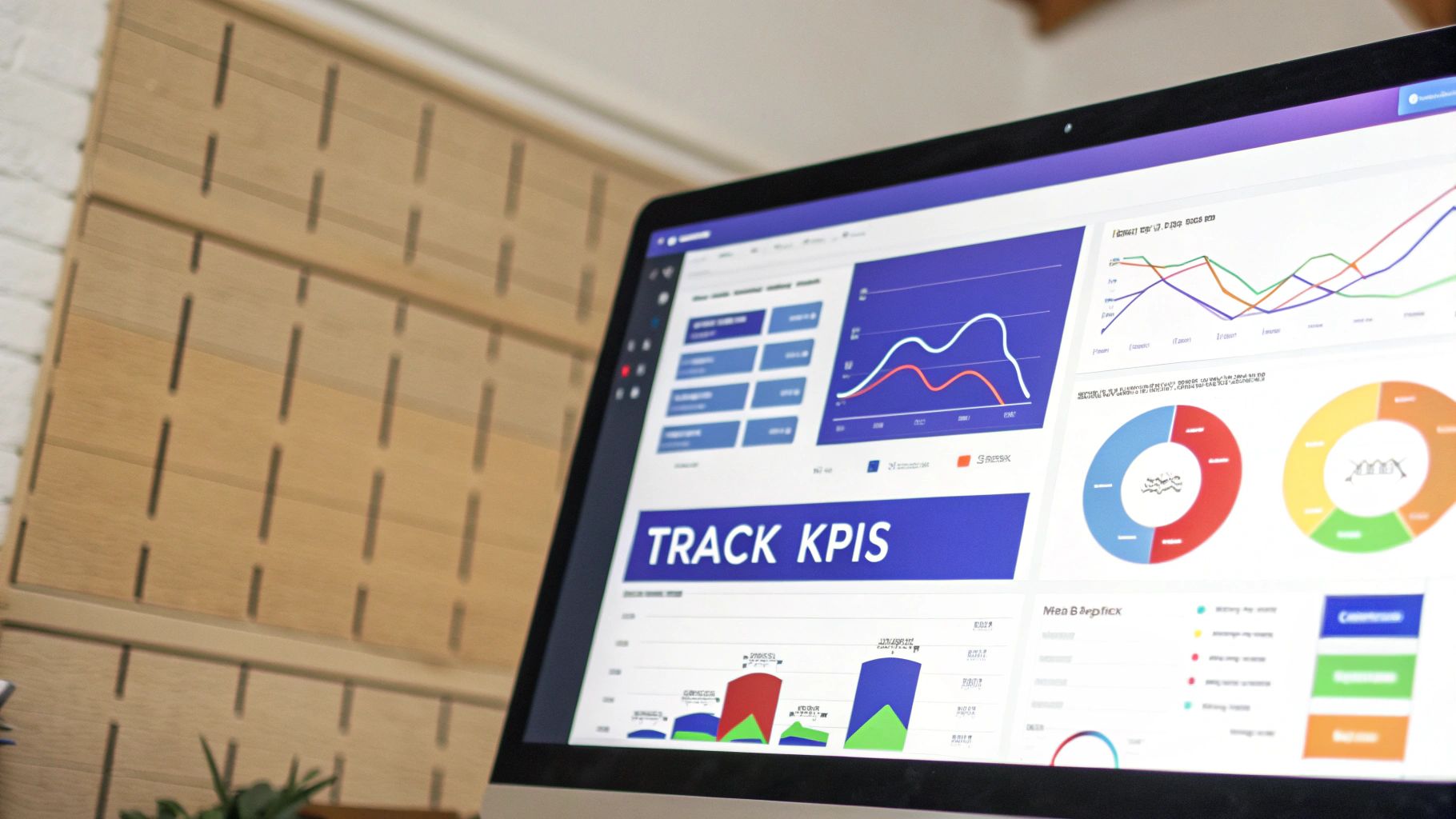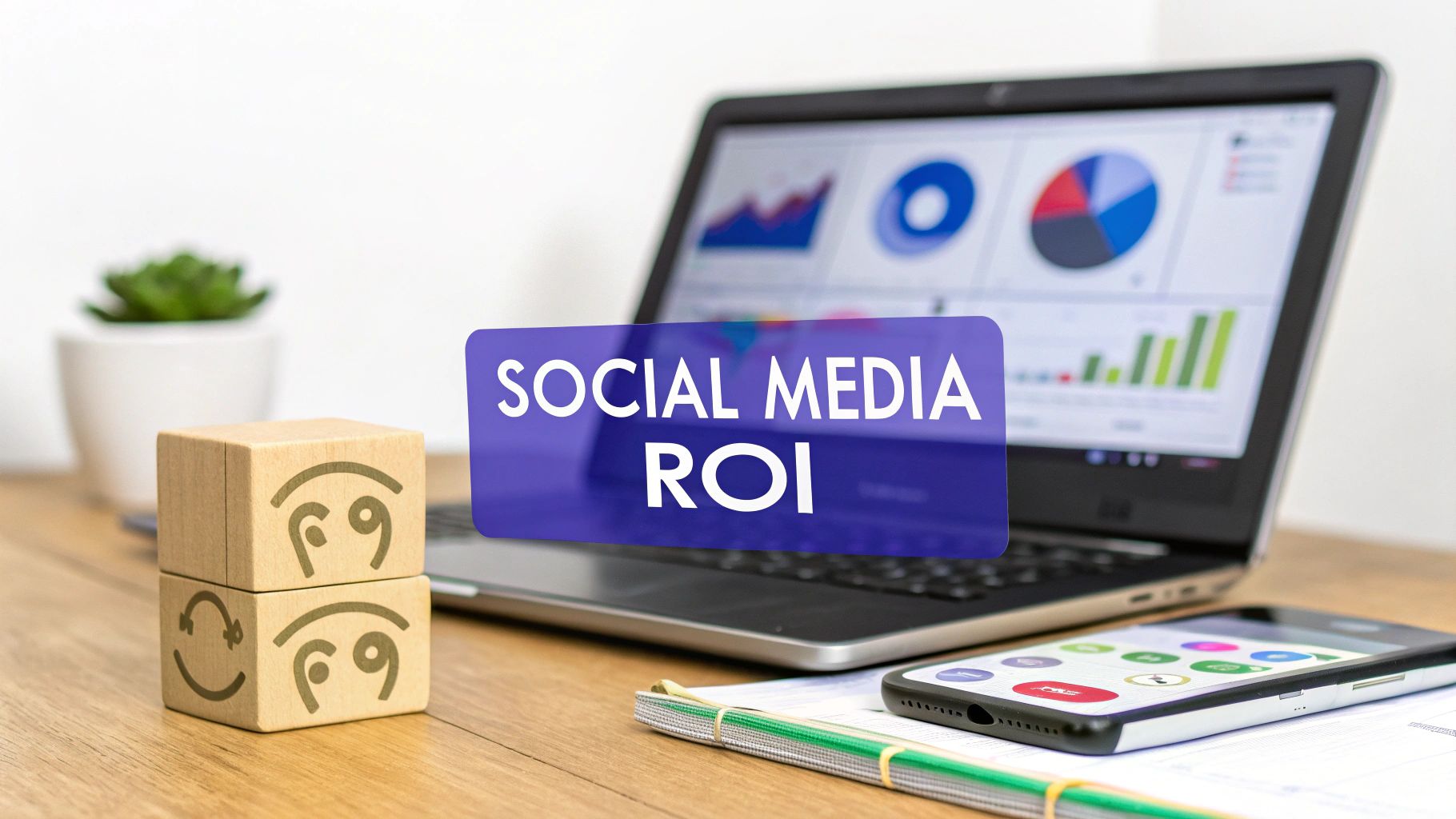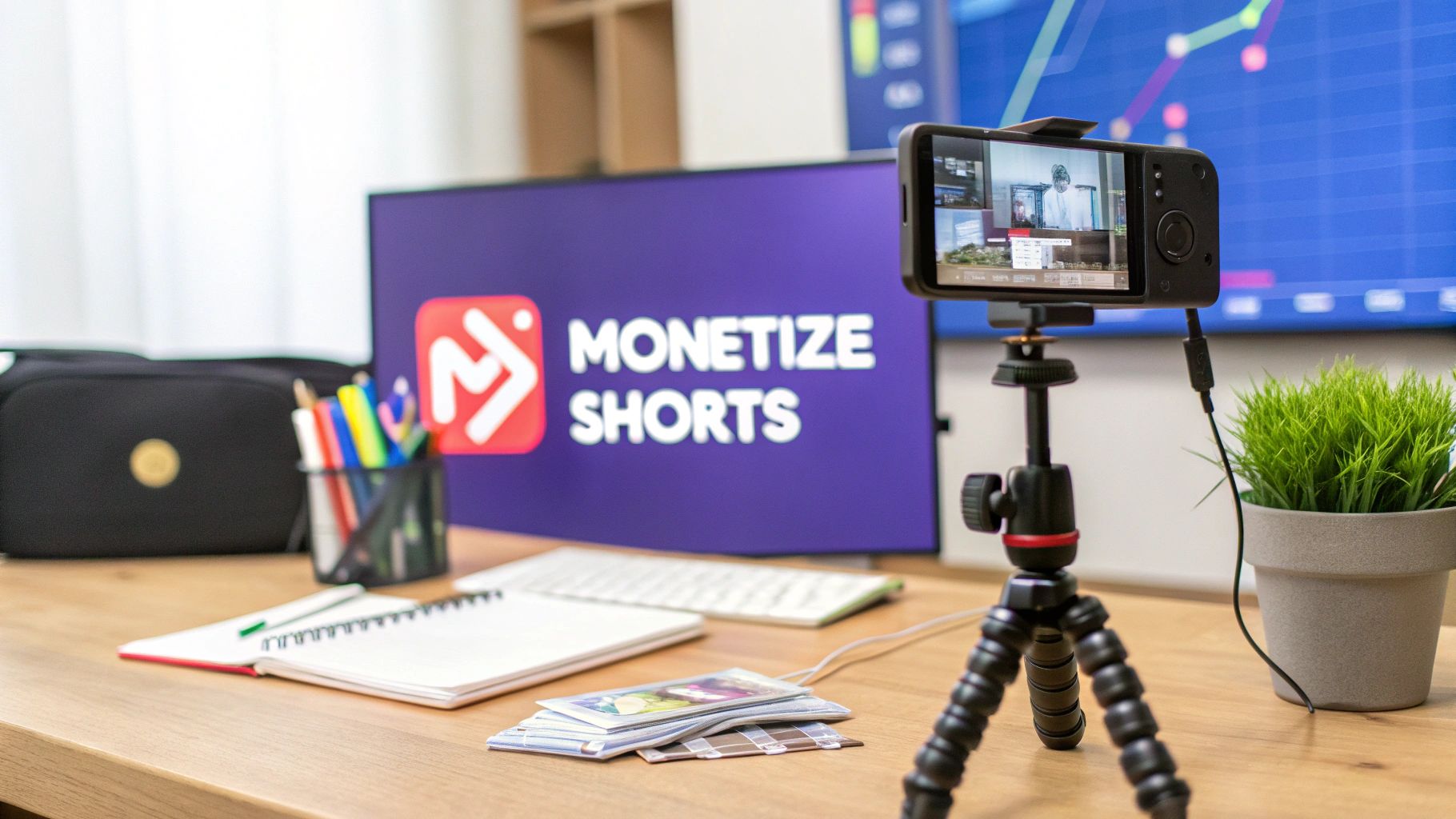At its core, calculating social media ROI seems straightforward. You take the profit you made from your social channels, subtract what you spent, divide that by your initial investment, and multiply by 100 to get a neat little percentage. Simple, right? But the real work is in the details—meticulously tracking every dollar spent and every dollar earned.
Moving Beyond Likes to Real Business Value

The pressure to prove the financial worth of social media has never been more intense. Let’s be real: rattling off high follower counts and engagement rates just doesn’t cut it anymore. Your boss, your clients, your stakeholders—they aren’t impressed by vanity metrics. The conversation has shifted, and it’s all about tangible business outcomes.
Today’s marketing leaders need to see a direct line connecting your social media budget to the company’s bottom line. That means showing exactly how your work on Instagram, LinkedIn, or TikTok is driving results that matter.
We're talking about things like:
- Lead Generation: How many quality leads came directly from that last campaign?
- Sales Revenue: What’s the total dollar value of sales that started on a social channel?
- Customer Lifetime Value (CLV): Are your social efforts creating loyal customers who keep coming back?
- Cost Reduction: Did your social customer service strategy lower call center costs?
This requires a fundamental mindset shift. You have to stop thinking of social media as just a brand awareness channel operating in a silo. It's a core component of your company's revenue engine and deserves the same financial scrutiny as any other business investment.
The Growing Demand for Proof
This isn't just a feeling; it's a well-documented trend. The push for measurable ROI has become a top priority as marketing budgets face more and more scrutiny. In fact, a staggering 77% of marketers say that proving ROI is more critical now than it was just two years ago. This pressure is also coming from the platforms themselves, which are increasingly rewarding genuine engagement over just broadcasting to the masses.
If you're interested in diving deeper, you can learn more about how to measure social media ROI with the right KPIs.
The real challenge is learning to speak the language of the C-suite: dollars and cents. When you can translate your social activities into financial results, you don’t just validate your strategy—you secure the budget you need to grow.
This guide is designed to move past the generic advice. We'll give you a practical, no-fluff framework for proving the financial value of your social media efforts. By the time you're done, you'll know exactly how to calculate your ROI and present it in a way that truly resonates with your business.
Connecting Social Goals to Business Objectives

Before you can even think about calculating a meaningful ROI, you have to know where you're going. Too many social media strategies aim for vague goals like "increasing engagement." That's like setting sail without a map—you'll definitely be busy, but you'll have no idea if you're actually getting closer to what your business needs.
The real magic happens when you translate broad business objectives into specific, actionable social media goals.
Let's say your company’s big-picture goal is to grab more market share. Your social media goal shouldn't just be to "get more followers." A much smarter, more connected goal would be to drive 500 new product trial sign-ups through a targeted Instagram campaign. See the difference? Now you've created a direct line between your social activities and a core business priority.
To do this right, your social media efforts can't live in a silo. They need to be woven into the company's wider growth plan, which is why understanding the essential elements of a successful digital marketing strategy is so important. It provides the context you need to make sure every tweet, post, and story is pushing the business forward.
From Vague Goals to Concrete KPIs
Once you've tied your social media plan to a real business outcome, the next step is picking the right Key Performance Indicators (KPIs) to track your progress. It's easy to fall into the trap of obsessing over vanity metrics. A viral post is great for a momentary high, but it’s just noise if it doesn't actually contribute to your goal.
Here’s how you can connect the dots from objectives to the right metrics:
Business Objective: Slash customer support costs.
- Social Goal: Cut support ticket volume by 15% by using a Twitter help thread to answer common questions.
- KPIs to Track: Number of support tickets deflected, sentiment analysis of customer replies, and cost per resolution on social media.
Business Objective: Funnel more qualified leads to the sales team.
- Social Goal: Bag 50 new marketing-qualified leads (MQLs) from a LinkedIn campaign promoting a new eBook.
- KPIs to Track: Landing page conversion rate, cost per lead, and the lead-to-MQL conversion rate.
This approach completely changes the conversation. Your social media reports transform from a boring list of disconnected numbers into a powerful story of business impact. Instead of just saying, "We got 1,000 likes," you can confidently report, "Our campaign generated leads valued at $25,000."
If you want to dive deeper into this process, we've got another guide on exactly how to measure social media success with the right metrics.
Here's a reality check: a huge gap often exists between what leadership wants and what marketers can actually deliver. While a whopping 65% of marketing leaders demand a direct link between social campaigns and business results, only 30% of marketers feel they can confidently measure social media ROI. The first step to bridging that gap is setting the right goals from day one.
Setting Up Your ROI Tracking System
If you're serious about measuring social media ROI, guessing won't cut it. You need a rock-solid system to gather clean, reliable data. This means going beyond the basic dashboards on Facebook or LinkedIn and building a real pipeline that follows a customer's journey—from their first click on a social post all the way to a sale on your website.
Think of yourself as a digital detective. Your job is to follow the footprints a user leaves behind. To do this well, you need two essential tools in your kit: tracking pixels and UTM parameters.
A tracking pixel, like the Meta Pixel or the LinkedIn Insight Tag, is just a small bit of code you add to your website. It acts as a bridge, connecting what people do on your site back to the social media ad that sent them there. This is how platforms report conversions, find more people likely to convert, and let you build powerful retargeting audiences.
The Power of UTM Parameters
While pixels are a must for paid ads, Urchin Tracking Module (UTM) parameters are your secret weapon for getting granular insights in tools like Google Analytics. These are just simple tags you add to the end of a URL to tell you exactly where your traffic came from.
A link with UTMs might look a little long, but it’s just telling a story. For example, a link for a summer sale campaign on Instagram could spell out:
- Source:
utm_source=instagram - Medium:
utm_medium=social - Campaign:
utm_campaign=summer_sale_2024
By getting into the habit of using UTMs for every single link you share, you kill any ambiguity. You'll know for sure which campaigns, or even which specific posts, are driving your most valuable traffic and sales.
Without consistent UTM tracking, all your social traffic gets dumped into one big bucket labeled "referral" in Google Analytics. This makes it impossible to connect revenue to specific campaigns, leaving you completely in the dark about what's actually working.
Bringing Your Data Together
The final step is connecting all the dots. Your social platform analytics, website data, and CRM can't live on separate islands. To get a true ROI figure, you have to integrate these sources to see the full picture, linking social activity to real business outcomes like leads and revenue.
This chart shows how that data flows from a simple social media interaction to a tangible business result, which is the foundation of your entire tracking setup.

As you can see, collecting data methodically is what feeds your entire analysis. This foundation is crucial for building reports that tell the real story.
To help structure this information in a way that’s easy to understand, I always recommend using a good social media analytics report template. It helps you organize your findings and present them clearly to stakeholders. By pulling data from Google Analytics and the social platforms themselves, you can paint a complete picture of how your efforts are impacting the bottom line.
Calculating Social Media ROI the Right Way
Okay, you've set your goals and have your tracking systems ready to go. Now it’s time to actually crunch the numbers.
At its core, the social media ROI formula is pretty straightforward: ROI = [(Return - Investment) / Investment] × 100%. It looks simple on paper, but the real magic—and the real work—is in figuring out what "Return" and "Investment" truly mean for your business.
This little formula is your North Star. It tells you whether your social media efforts are a money-making machine or just a costly hobby. Let's break down both sides of the equation so you can get a clear, honest picture of your performance.
Tallying Up Your Total Social Media Investment
The first rookie mistake I see all the time is under-reporting costs. Your "investment" isn't just your ad budget. Not even close. To get an accurate ROI, you have to account for every single dollar and every minute of time spent on your social media program.
A complete breakdown of your investment should include:
- Ad Spend: The obvious one. This is the total cash you’re putting into boosted posts and paid social campaigns.
- Content Creation: What did it cost to make those beautiful graphics, videos, and killer captions? Factor in any fees for designers, videographers, or copywriters.
- Team Salaries: This is a huge, often-missed expense. Calculate the hourly wages of your social media manager (or anyone else involved) and multiply it by the hours they dedicate to social media each week.
- Social Media Tools: Don't forget the monthly or annual subscriptions for your scheduling, analytics, and management platforms like PostSyncer.
- Agency or Freelancer Fees: If you’ve outsourced any part of your social media, those invoices are a direct part of your investment.
When you add all of these up, you get your true total investment. Anything less is just giving you a vanity ROI number that won't hold up under scrutiny.
You know the old saying, "A dollar saved is a dollar earned"? It's spot on here. When you track your costs this meticulously, you start seeing where the money is really going. It helps you spot inefficiencies and make smarter budget decisions, which boosts your ROI without even making another sale.
Assigning a Monetary Value to Your Return
Now for the fun part: the return. This is where you connect your social media activities to actual, cold, hard cash. Direct sales are the easiest to measure, but you also need to get good at assigning a dollar value to other conversions that move the needle.
For an e-commerce brand, it’s often a straight line. Someone clicks your Instagram ad and makes a $150 purchase. Boom, that’s your return.
For a SaaS business, it takes a bit more finesse. Let's imagine a LinkedIn campaign brings in 20 high-quality leads. You’ve worked with your sales team and know that, on average, a good lead is worth $250. Just like that, your campaign's return is $5,000. The trick is to have that internal conversation and agree on what a lead, a demo request, or a trial signup is actually worth.
A lot of the thinking behind social media ROI lines up with broader marketing measurement. Digging into some marketing automation ROI secrets shared by seasoned pros can give you some great ideas that apply here, too.
Once you've meticulously tracked your full investment and the total monetary value of your returns, you can finally plug those numbers into the formula with confidence. This is how you transform ROI from a fuzzy buzzword into a solid, defensible metric that proves your worth to the business.
Turning ROI Data into Strategic Decisions
Gathering data and crunching the numbers is really only half the job. A social media ROI figure, no matter how impressive it looks on a spreadsheet, is completely useless until you actually do something with it. This is where the magic happens—when raw data becomes a strategic asset that steers your future marketing investments.
It's time to move beyond simple reports. Your real goal is to craft a compelling story for stakeholders that clearly shows the value you’re bringing to the table. This isn't just about showing off numbers; it’s about illustrating your impact.
From Analysis to Actionable Insights
The best marketing teams I've worked with use ROI data as their primary decision-making tool. Once you know your ROI for different platforms, specific campaigns, and even content types, you can start making much smarter choices with real confidence. A positive ROI proves what’s working, and a negative ROI gives you the green light to stop what isn't.
Think about it this way: imagine your analysis reveals that an Instagram Stories campaign delivered a 150% ROI, but your efforts on X (formerly Twitter) are sitting at a -20% ROI. This isn't a failure; it’s a road map. It’s pointing you exactly where to double down and where to pull back.
The most powerful thing about ROI data is its ability to kill the guesswork. It replaces "I think we should do this" with "The data proves we must do this," giving your strategy a solid, evidence-based backbone.
This kind of clarity allows you to confidently reallocate your budget away from underperforming channels and toward high-impact activities. You can finally justify shifting resources to produce more of the content that you know drives real returns.
Optimizing and Justifying Your Budget
A clear, concise ROI report is your best friend during budget talks. When you can walk into a meeting and show that for every $1 you spent on social media, the company got $4 back, you completely change the conversation. You’re no longer just asking for money; you’re presenting a proven investment opportunity.
Here’s how you can use that data to fine-tune your performance and get the budget you deserve:
- Spotlight Your Top Performers: Pinpoint the specific campaigns or content formats with the highest ROI. For instance, if short-form video content is consistently knocking it out of the park compared to static images, you have a clear mandate to create more of it. If you're just getting started, diving into a guide on video marketing for social media can give you a fantastic launchpad.
- Cut Underperforming Campaigns: Be ruthless. If a campaign is bleeding money with no return, use your data to make the case for shutting it down and moving those funds elsewhere. No more emotional attachments to "pet projects."
- Test and Pivot with Confidence: Use your current ROI calculations as a baseline for A/B testing. Try out new platforms, experiment with different ad formats, or test new messaging, and measure the results against your established benchmarks. This enables you to make smart, strategic pivots instead of just guessing.
By consistently analyzing and acting on your ROI, you create a powerful feedback loop. Each campaign becomes a little smarter and more efficient than the last, driving continuous improvement and maximizing the financial impact of your entire social media program.
Common Questions About Measuring Social Media ROI
Even with a solid plan in place, measuring social media ROI brings up some tough, real-world questions. I've been there. Getting clear on these common challenges is what separates a confident, effective strategy from one that just fizzles out.
Let’s tackle some of the most frequent hurdles marketers face when trying to connect their social efforts to the bottom line.
How Can I Measure ROI For Brand Awareness Campaigns?
I get this question all the time. Measuring a direct, dollar-for-dollar return on brand awareness feels fuzzy, but it's not impossible. The trick is to stop looking for immediate sales and start tracking proxy metrics that show your influence is growing over time.
Instead of hunting for a direct purchase link from an awareness post, keep a close eye on KPIs that signal a growing brand presence. This includes things like:
- Reach and Impressions: Are more people simply seeing your brand?
- Share of Voice: How much of the conversation in your niche are you owning compared to competitors?
- Branded Search Volume: Are more people typing your brand name directly into Google? You can check this in Google Search Console.
Look for a clear connection between these awareness metrics and other key business indicators. For example, did a spike in your Instagram reach last month correlate with a lift in direct website traffic this month? While it’s not a perfect 1-to-1 equation, this approach shows how top-of-funnel activities fill the pipeline for future growth.
What Common Mistakes Should I Avoid When Measuring ROI?
It's surprisingly easy to make mistakes that completely throw off your ROI calculations. The biggest one I see is relying only on last-touch attribution. This model gives 100% of the credit for a sale to the very last click, totally ignoring the critical role social media played in introducing and nurturing that customer from the start.
Another frequent misstep is under-reporting your investment. It’s not just about ad spend. So many marketers forget to include crucial costs like:
- Team member salaries and the time they spend on social.
- Expenses for content creation (think video editing, design, photography).
- Monthly fees for your social media tools.
Forgetting these costs will make your ROI look way better than it actually is. You can sidestep these traps by using a multi-touch attribution model, tracking every single dollar and hour invested, and—most importantly—setting a clear, monetizable goal from day one.
A huge mistake is thinking virality equals positive ROI. A post with a million views that drives zero qualified leads or sales is just noise. Focus on content that addresses audience pain points and aligns with your financial goals, not just what might go viral.
How Often Should I Calculate And Report On Social Media ROI?
The right reporting schedule really depends on your business cycle and campaign length. There's no magic answer, but a good rule of thumb is to sync your reporting with your company's existing planning rhythms.
For your ongoing, "always-on" social media marketing, a monthly or quarterly ROI analysis usually hits the sweet spot. This gives you enough data to spot real trends without getting bogged down in daily noise.
But for specific, short-term campaigns—like a holiday sale or a product launch—you need to calculate the ROI as soon as it ends to measure its immediate impact and learn what worked.
Which Tools Are Best For Measuring Social Media ROI?
Here’s the thing: no single tool does it all. The smartest approach is to build an integrated tech stack where each tool plays to its strengths.
Your foundation should always be Google Analytics. Use it to track website traffic, goal completions, and e-commerce conversions, making sure your links are tagged with consistent UTM parameters. You'll then want to pair this with the native analytics from each platform (like Meta Business Suite or LinkedIn Analytics) for channel-specific performance data.
To bring it all together, integrated platforms like HubSpot, Sprout Social, or our own PostSyncer are invaluable. These tools connect your social media activity directly to your CRM data. This allows you to link a specific tweet or post to actual sales revenue and customer lifetime value, giving you a true, undeniable ROI figure.
Ready to stop guessing and start proving your social media's worth? PostSyncer provides the comprehensive analytics and integrated reporting you need to track performance, connect social activity to business goals, and calculate your ROI with confidence. Start your free trial and see the real impact of your work.















